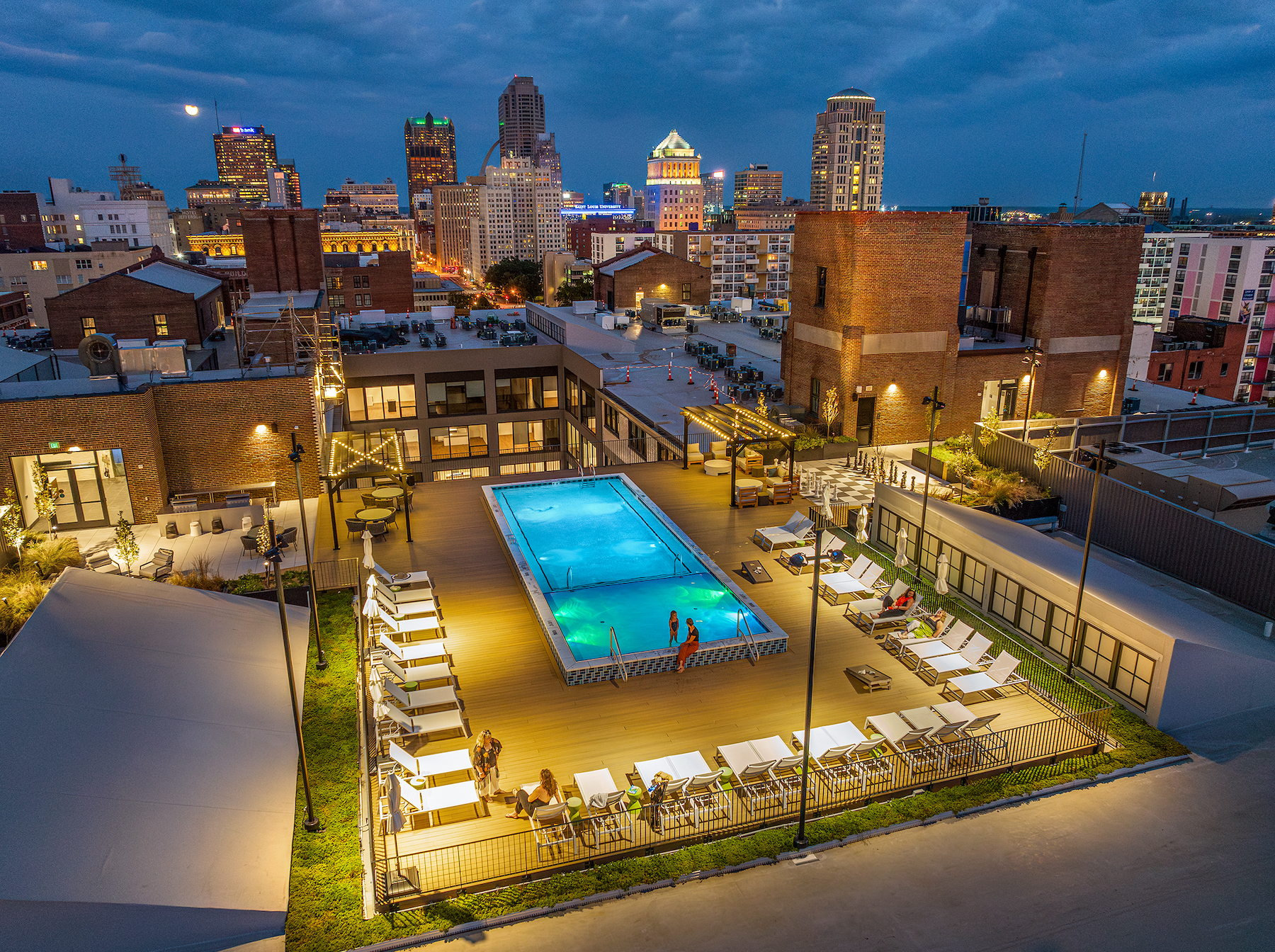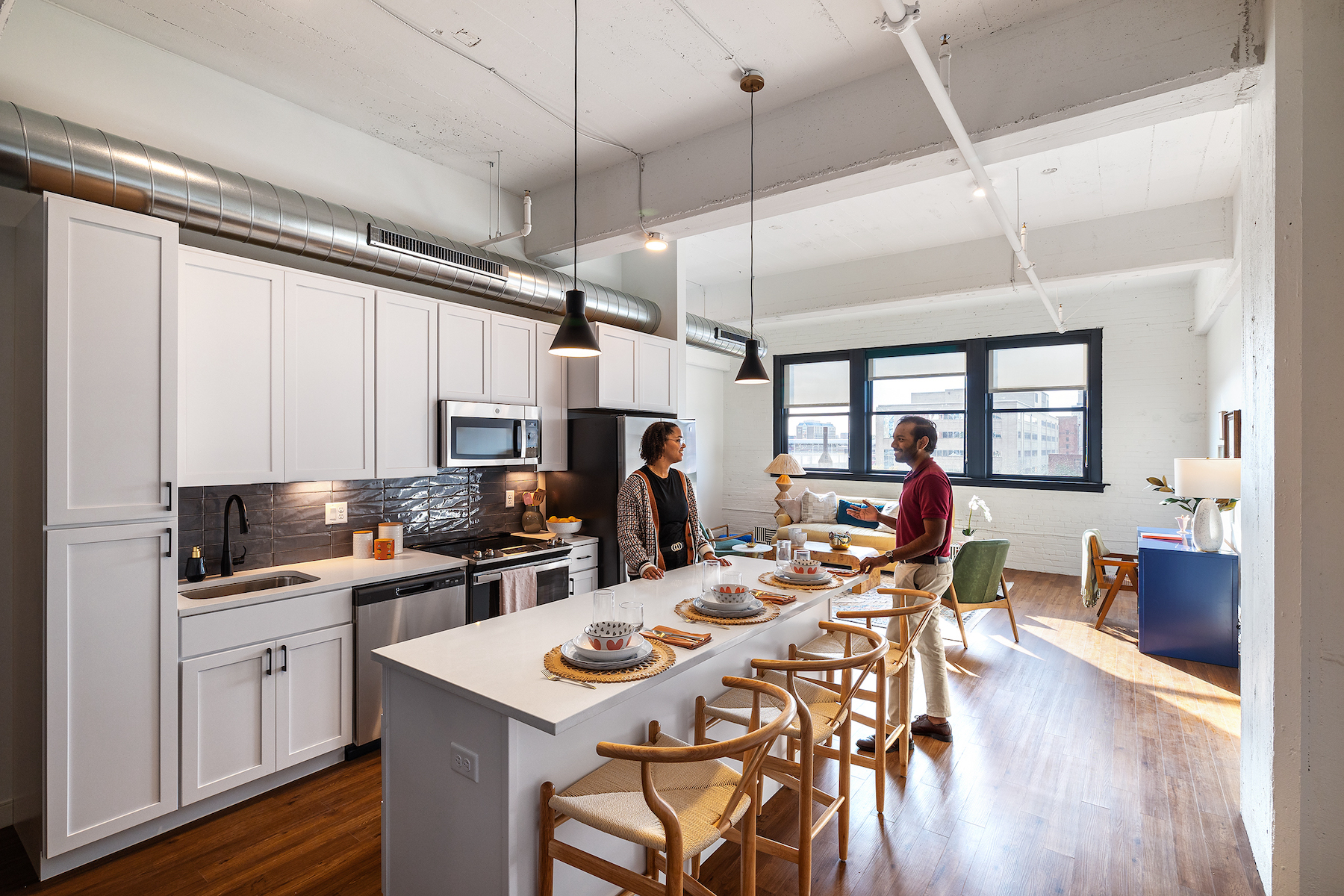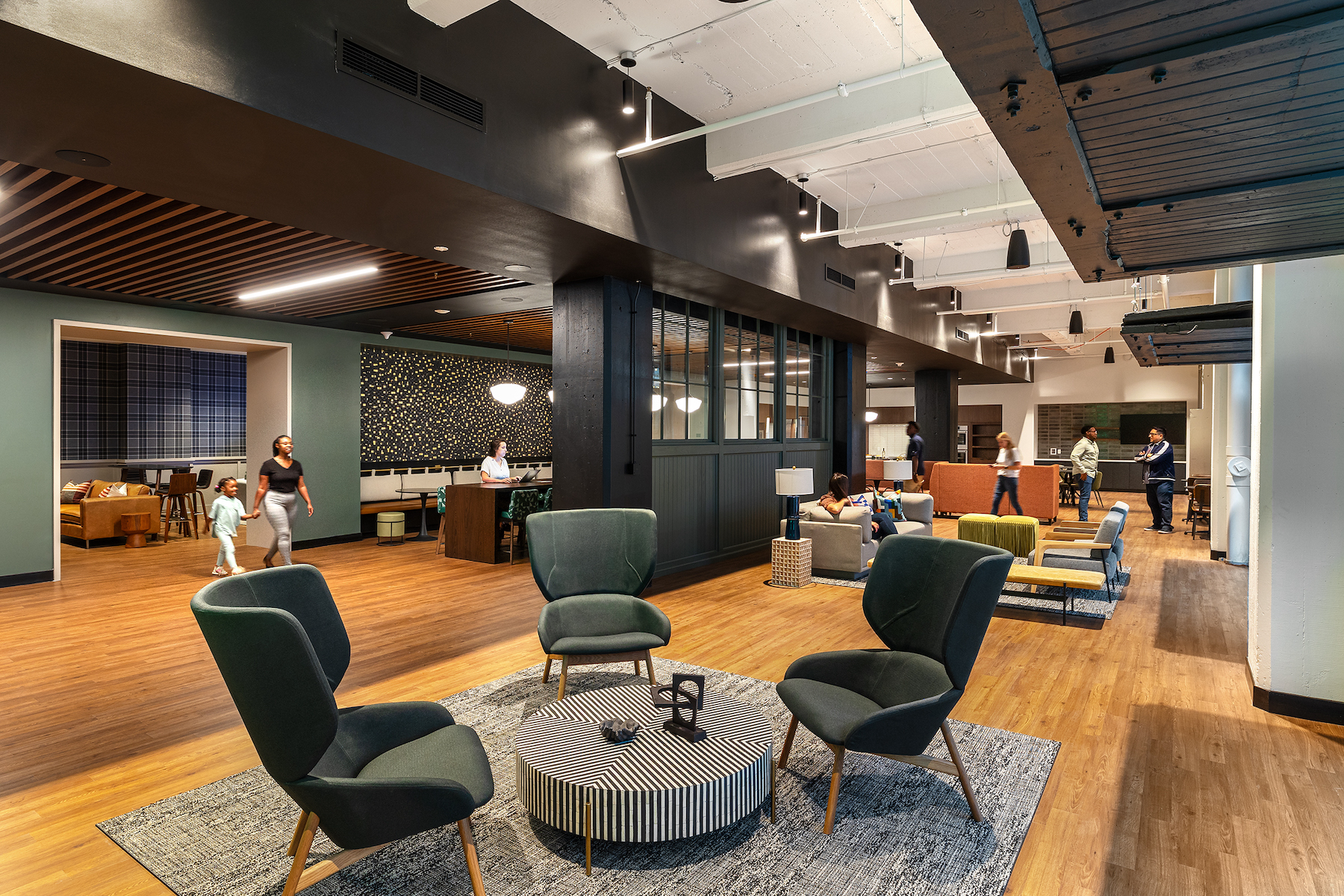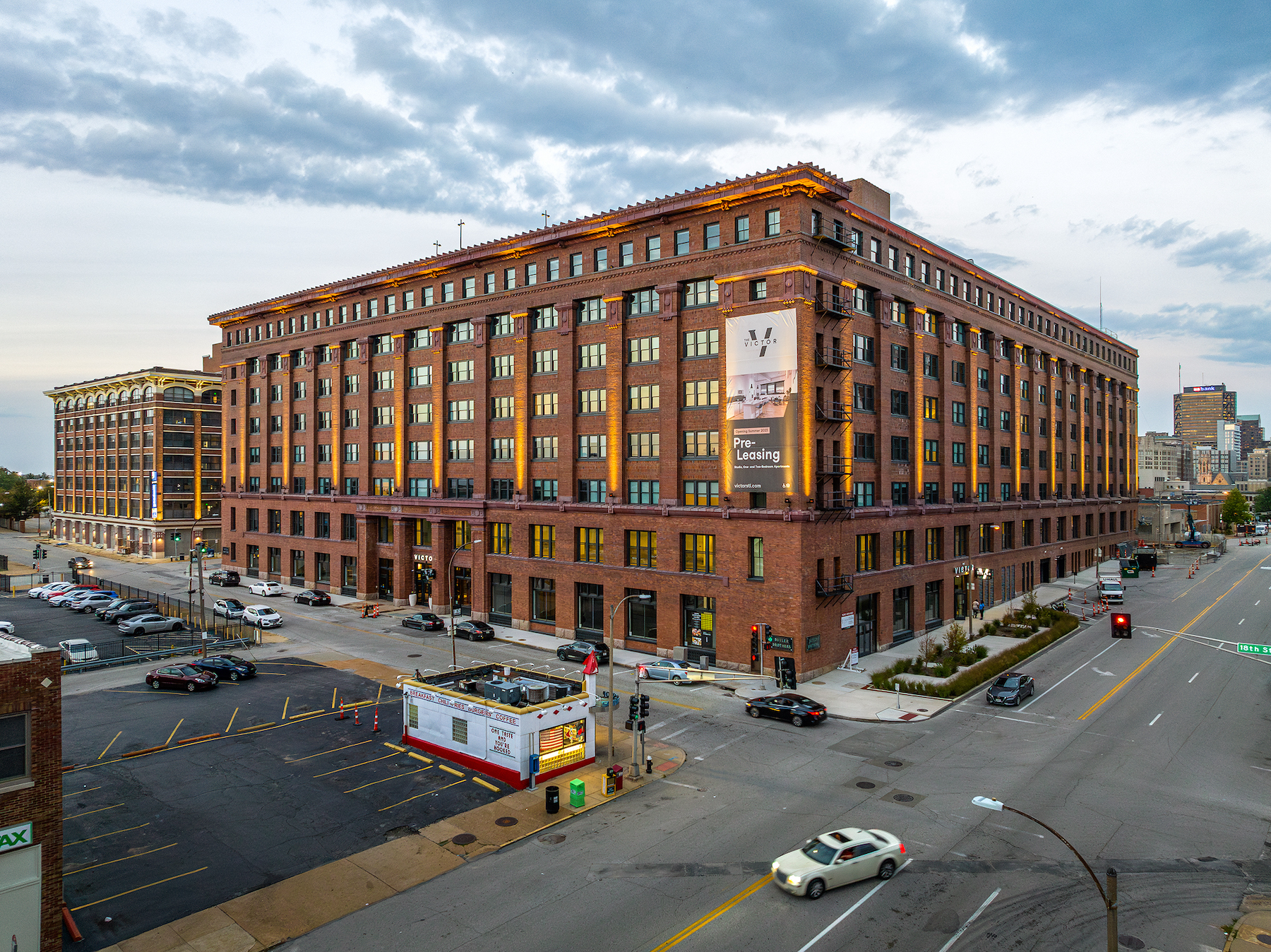The Butler Brothers Building opened in 1906, in St. Louis’s former Garment District. The 735,000-sf building served as a warehouse distribution center, and at the time of its construction was one of the largest reinforced concrete structures west of the Mississippi River.
Last June was the one-year anniversary of the completion of this building’s adaptive reuse transformation as The Victor, a multifamily community with nearly 400 apartments, retail and coworking spaces, and amenities.

The Victor brought back to life a building that had been vacant for more than two decades, said Joel Fuoss, AIA, LEED AP, a Principal with Trivers, the architect-interior designer on this $130 million project, which was developed by Development Services Group.
Residents of The Victor have access to amenities that include an expansive rooftop terrace with a pool, a pickleball court, sundeck, dog park, fitness center with yoga and Pilates studios and a golf simulator, a parking garage, coworking and conference spaces, and outdoor courtyards. The building itself is located next to St. Louis CITY SC’s CityPark soccer stadium.
The apartments range from a 531-sf studio that starts at $1,345 per month to a 1,384-sf two-bedroom unit starting at $2,578 per month.

Adaptive reuse respects the past
Trivers and its design team restored the building’s exterior brick to its original color and revitalized the remaining terracotta cornices. The design retained the building’s clam-shell style garage doors that once opened for horse-drawn wagons. The building’s history was also incorporated throughout the interior’s renovation, including patterns and colors from early 20th Century fashion trends, and an oversized chessboard on one of the rooftop lounges that acknowledges the building’s location in a district and the former Harmonie Hall site that hosted the 1886 World Chess Championship.
Gary Prosterman, President and CEO of Development Services Group, said that his company and a team led by members of Trivers and Paric Corp., the project’s general contractor, conducted due diligence on the building a year before construction started to identify and address any problematic issues. “An undertaking this significant would not be p possible without the attention to detail and historic building expertise that the Trivers team brings to the table,” he said.

By repurposing the building’s existing concrete and masonry, the building team minimized the need to extract and produce new materials, which are carbon intensive. “The embodied carbon put into this building nearly 120 years ago would take St. Louis’ Forest Park [neighborhood] another 100 years to offset if built today,” said Fuoss.
Other AEC firms on the project team included IMEG (MEP engineer), KPFF Consulting Engineers (SE), Civil Design Inc. (CE), Arbolope Studio (landscape architect), Reed Burkett Lighting Design (lighting designer), Cohen Hilberry Architects (accessibility consultant), and Wollenburg Building Conservation (masonry consultant).
Related Stories
Adaptive Reuse | Sep 19, 2023
Transforming shopping malls into 21st century neighborhoods
As we reimagine the antiquated shopping mall, Marc Asnis, AICP, Associate, Perkins&Will, details four first steps to consider.
Adaptive Reuse | Sep 15, 2023
Salt Lake City’s Frank E. Moss U.S. Courthouse will transform into a modern workplace for federal agencies
In downtown Salt Lake City, the Frank E. Moss U.S. Courthouse is being transformed into a modern workplace for about a dozen federal agencies. By providing offices for agencies previously housed elsewhere, the adaptive reuse project is expected to realize an annual savings for the federal government of up to $6 million in lease costs.
Office Buildings | Sep 14, 2023
New York office revamp by Kohn Pedersen Fox features new façade raising occupant comfort, reducing energy use
The modernization of a mid-century Midtown Manhattan office tower features a new façade intended to improve occupant comfort and reduce energy consumption. The building, at 666 Fifth Avenue, was originally designed by Carson & Lundin. First opened in November 1957 when it was considered cutting-edge, the original façade of the 500-foot-tall modernist skyscraper was highly inefficient by today’s energy efficiency standards.
Adaptive Reuse | Sep 13, 2023
Houston's first innovation district is established using adaptive reuse
Gensler's Vince Flickinger shares the firm's adaptive reuse of a Houston, Texas, department store-turned innovation hub.
MFPRO+ Research | Sep 11, 2023
Conversions of multifamily dwellings to ‘mansions’ leading to dwindling affordable stock
Small multifamily homes have historically provided inexpensive housing for renters and buyers, but developers have converted many of them in recent decades into larger, single-family units. This has worsened the affordable housing crisis, say researchers.
Adaptive Reuse | Aug 31, 2023
New York City creates team to accelerate office-to-residential conversions
New York City has a new Office Conversion Accelerator Team that provides a single point of contact within city government to help speed adaptive reuse projects. Projects that create 50 or more housing units from office buildings are eligible for this new program.
Adaptive Reuse | Aug 31, 2023
Small town takes over big box
GBBN associate Claire Shafer, AIA, breaks down the firm's recreational adaptive reuse project for a small Indiana town.
Adaptive Reuse | Aug 17, 2023
How to design for adaptive reuse: Don’t reinvent the wheel
Gresham Smith demonstrates the opportunities of adaptive reuse, specifically reusing empty big-box retail and malls, many of which sit unused or underutilized across the country.
Adaptive Reuse | Aug 16, 2023
One of New York’s largest office-to-residential conversions kicks off soon
One of New York City’s largest office-to-residential conversions will soon be underway in lower Manhattan. 55 Broad Street, which served as the headquarters for Goldman Sachs from 1967 until 1983, will be reborn as a residence with 571 market rate apartments. The 30-story building will offer a wealth of amenities including a private club, wellness and fitness activities.
Adaptive Reuse | Jul 27, 2023
Number of U.S. adaptive reuse projects jumps to 122,000 from 77,000
The number of adaptive reuse projects in the pipeline grew to a record 122,000 in 2023 from 77,000 registered last year, according to RentCafe’s annual Adaptive Reuse Report. Of the 122,000 apartments currently undergoing conversion, 45,000 are the result of office repurposing, representing 37% of the total, followed by hotels (23% of future projects).


















